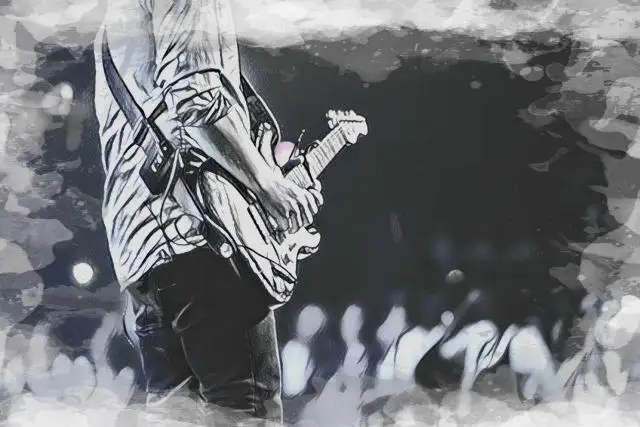If you're a songwriter looking to add a bit more soul to your R&B chord progressions, you've come to the right place. Today, I want to break down all there is to know about R&B chord progressions, including what makes them so unique and what kinds of techniques you can use to get that rich, colorful, tasty, and sometimes stanky , R&B sound.
Let's dive in!
The Anatomy of R&B Chord Progressions
R&B has come a long way since it originated in the 1940s
Initially, it combined elements of jazz, blues, and gospel music and was characterized by its soulful vocals, strong backbeat, and undeniable groove.
Over the decades, R&B has evolved. Now, it incorporates influences from funk, hip-hop, pop, and electronic music. Even so, it seems to maintain its core emotional elements.
Today, R&B is often defined by its smooth melodies and intricate harmonic layers.
One of the most important elements in R&B is the chord progression .
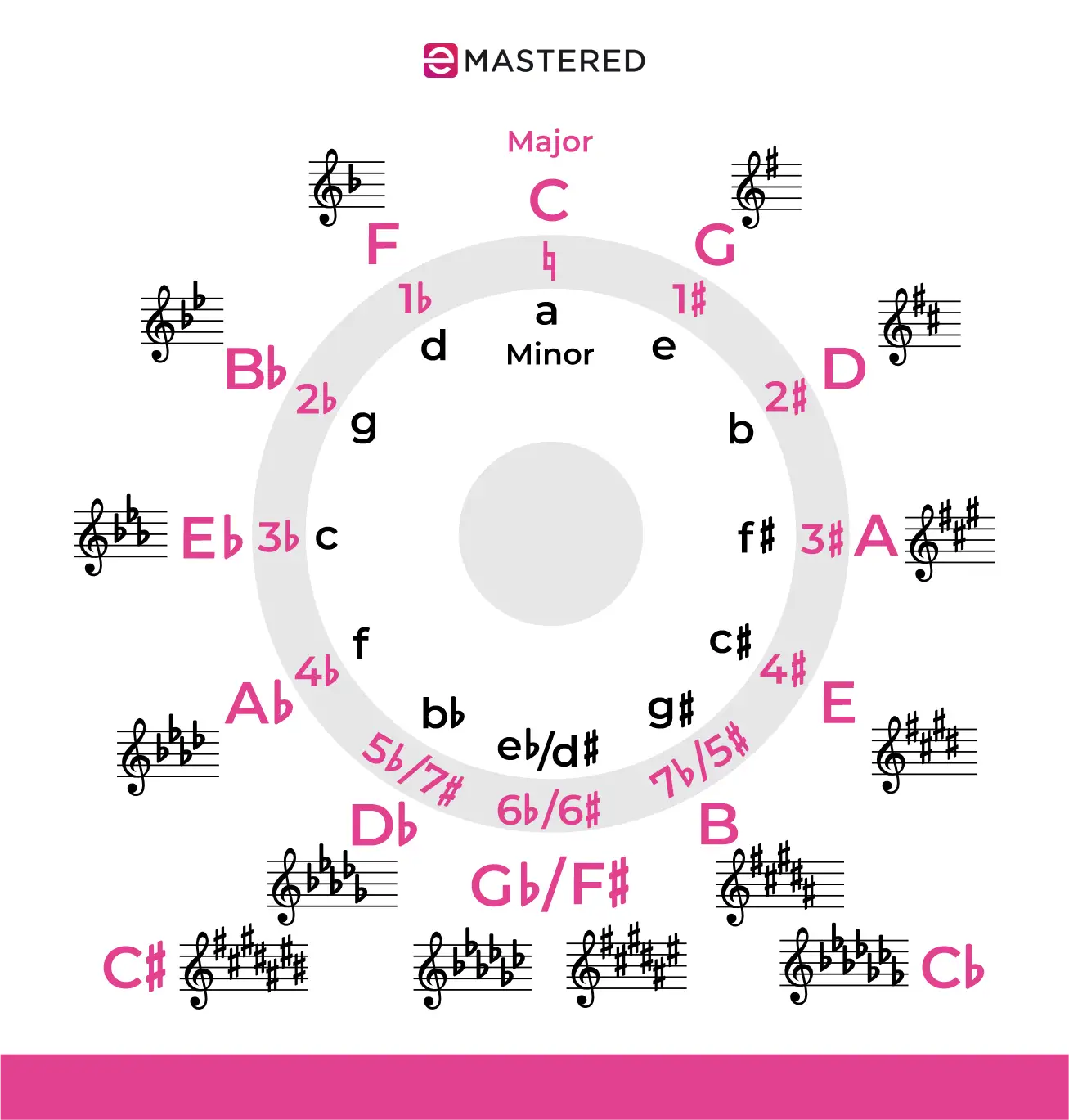
Unlike more straightforward genres, R&B utilizes complex chord progressions that often include extended and altered chords like 7ths, 9ths, 11ths, and 13ths. Many R&B songwriters will also use specific techniques to make their chords more interesting, such as unique voice leading or dissonance.
Key Signatures: The Foundation of R&B Chord Progressions
At the foundation of every chord progression is a key signature , which defines the set of pitches that a piece of music uses and establishes the tonal center around which melodies and harmonies are built.
In R&B, key signatures are particularly influential for several reasons:
- Harmonic Foundation: The key signature provides the harmonic foundation for a song. It determines which chords are naturally occurring within the key, so you can create a more cohesive sound throughout the piece.
- Consistency and Flow: By establishing a key signature, a song maintains a consistent tonal framework. Every chord, melody, and harmony can work together, which is how you get a smooth, flowing sound.
- Emotional Impact: Different key signatures can evoke different emotional responses. For instance, some keys may be perceived as brighter or darker, warmer or cooler, affecting how listeners experience the music.
The Difference Between Major and Minor Keys
There are two types of keys you'll choose between when writing a chord progression - a major key or a minor key.
Major keys are often associated with a bright, happy, and uplifting sound. They are built on major scales, which have a whole and half-step pattern. They're great for upbeat or celebratory R&B tracks.
Minor keys , on the other hand, have a darker, more melancholic sound. They are built on minor scales, which have a different pattern of whole and half steps, which create a sense of tension and introspection. At their foundation, songs in minor keys often evoke feelings of sadness, longing, and depth. You'll usually hear them in R&B ballads and soulful tracks that explore themes of love or heartache.
Major vs. Minor Chords
Whether you play in a major or minor key, you'll come across two basic types of chords - major and minor chords.
Major chords are the most fundamental building blocks of music, especially in Western harmony. They have bright and happy sound, compared to their minor cousins. We construct major chords using three notes: the root, the major third, and the perfect fifth.
So, if we had a C Major chord, it would look like this:
- C (Root) : The starting note of the chord, which gives the chord its name.
- E (Major Third): The note that is four half steps (or semitones) above the root.
- G (Perfect Fifth) : The note that is seven-half steps above the root.
Whenever you're trying to convey a sense of happiness, brightness, or optimism, a major chord is a great starting point!
From there, we move to minor chords, which are equally essential. However, these chords have more of a somber and melancholic sound, providing a nice contrast to the major chord. A minor chord is also constructed using three notes: the root, the minor third, and the perfect fifth.
If we had an A minor chord, which is the relative minor of C major, it would look like this:
- A (Root) : The starting note of the chord.
- C (Minor Third) : The note that is three half steps (or semitones) above the root, giving the chord its minor quality.
- E (Perfect Fifth) : Similar to the major chord, this note is seven half steps above the root.
Whenever you want to convey a sad or introspective mood, minor chords are a great choice!
Advanced R&B Chord Techniques
Major and minor chords are only the foundations of R&B music, as most progressions you hear in this genre often employ more intricate and sophisticated harmonic structures.
Let's take a look at some of the more advanced R&B chord techniques you can use to give your music more color.
Chord Inversions
We'll start off with chord inversions, which occur when the notes of a chord are rearranged so that a note other than the root is the lowest note. This technique changes the bass note of the chord, which can alter its overall sound and feel.
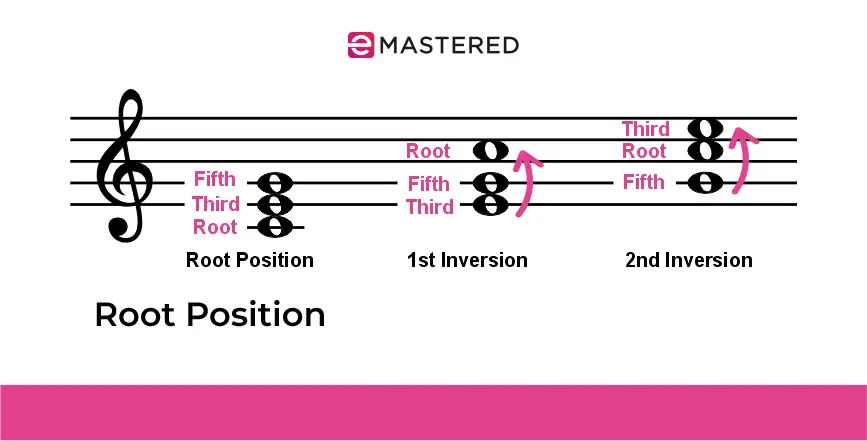
For example, in a C major chord (C-E-G), the root position has C as the lowest note. If we move C to the top and play E as the lowest note, we get the first inversion (E-G-C). If we move E to the top and play G as the lowest note, we get the second inversion (G-C-E).
There are a few reasons why we use inversions:
- Harmonic Interest: Inversions are a great tool for adding variety and interest to a chord progression, especially when root note chords start sounding monotonous. Different inversions provide different textures and colors, and there is plenty to experiment with, especially once we get into extended chords.
- Smoother Voice Leading: Inversions also allow for smoother transitions between chords. As a pianist, this can minimize the movement between notes, creating a more connected harmonic progression. For example, if we want to move from C major (C-E-G) to G major (G-B-D), we can use the first inversion of G major (B-D-G) to reduce the leap between the bass notes.
- Moving Bass Lines: Bass plays such an important role in R&B, and inversions can create more interesting and melodic bass lines. By changing the bass note, you can guide a listener's ear in whatever direction you choose. In a progression like Dm-G-C, using Dm (D-F-A), G/B (B-D-G), and C (C-E-G) creates a descending bass line (D-B-C) that adds a sense of direction.
If you're a keyboardist, one way to practice chord inversions is by taking a progression and trying to move from one chord to the next with minimal hand movement. While doing so, take note of any chords you end up on where the root note is not the lowest note.
Extended Chords
Extended chords go beyond the basic triad (root, third, and fifth) by adding additional notes such as the 7th, 9th, 11th, and 13th. With more notes, you get added depth and complexity, which have become staples of R&B music.
If we look back in history, we can see that R&B has long relied on extended chords to create its signature smooth and sophisticated sound.
One of the main reasons we use them in R&B is that they make harmony more interesting. For example, to play a Cmaj7 chord (C-E-G-B), we add a major seventh to the basic C major triad to create a fuller, more resonant sound.
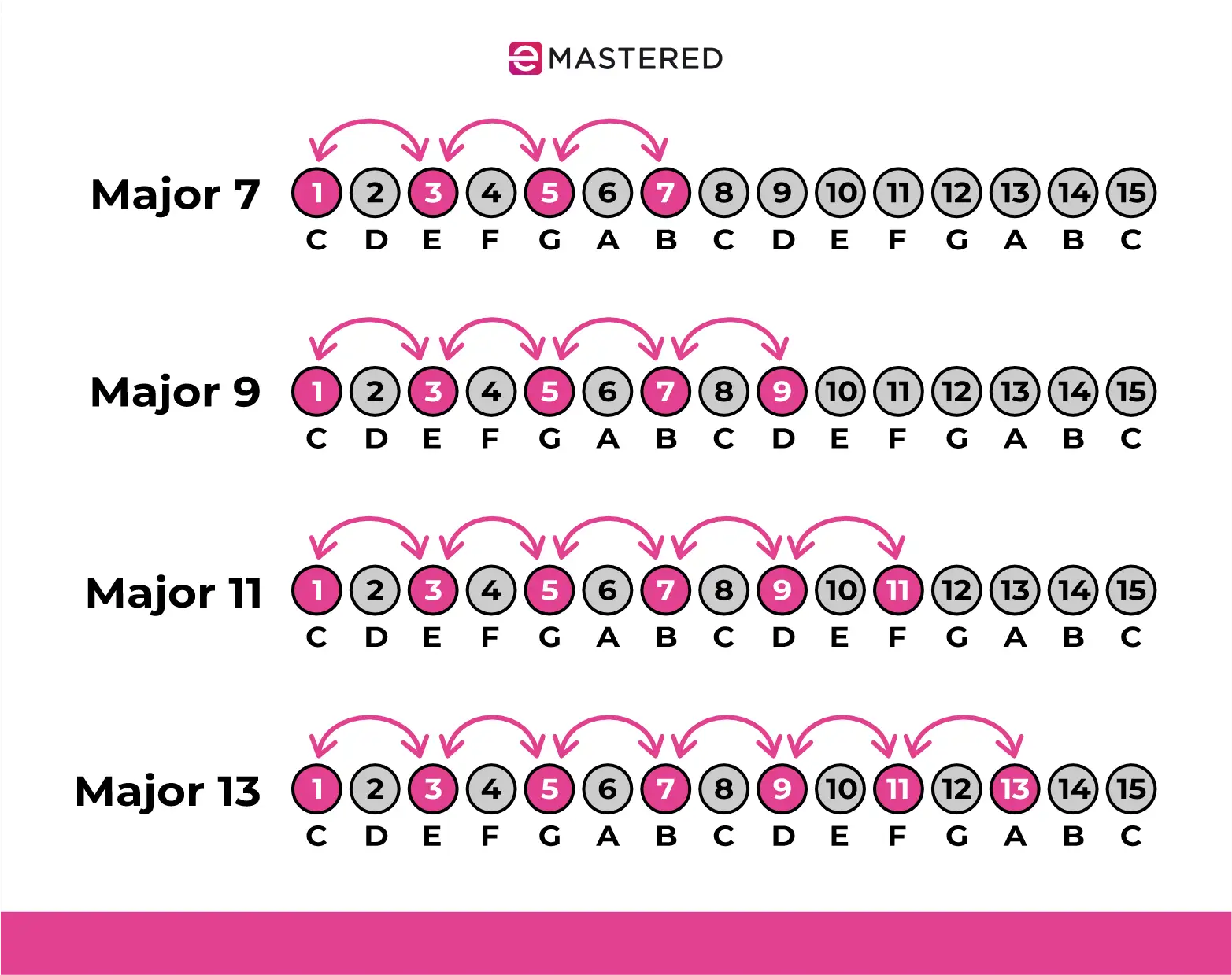
Extended chords can also create subtle dissonances and resolutions. For a minor 9 chord, such as the Dm9 chord (D-F-A-C-E), we add a ninth (E) to the already extended D minor 7 chord to give it that extra bit of soul.
It's also worth noting that extended chords make for smoother transitions between chords, which is crucial for the smooth, laid-back feel of R&B. For example, moving from a G7 (G-B-D-F) to a Cmaj7 (C-E-G-B) chord, the notes F (7th of G7) and B (7th of Cmaj7) lead smoothly to each other.
Borrowed Chords
Getting into the more advanced chord techniques, we have borrowed chords , which are chords taken from a parallel key (major or minor) and used in the original key of a song.
For instance, if a song is in a major key, a borrowed chord might come from the parallel minor key.
It's important to remember that these chords use notes that are not diatonic (naturally found) in the original key. As a result, they add a unique, unexpected flavor.
For example, in the key of C major, a borrowed chord from the parallel minor (C minor) might be A♭ major (A♭-C-E♭). While A♭ major is not part of the C major scale, it can be "borrowed" to create a different mood or effect.
Modal Interchange
Next, we have modal interchange , which is the technique of borrowing chords from parallel modes (different scales that share the same tonic note) and incorporating them into a progression.
For example, if a piece is in the key of C major, modal interchange might involve borrowing chords from C minor, C Dorian, or other modes that have C as their root. Again, this is simply another way to add variety and depth to your chord progressions.
Slash Chords
Slash chords, sometimes referred to as compound chords, are chords where the bass note (the note after the slash) is different from the root note of the chord (the note before the slash). Essentially, the chord symbol indicates a specific chord to be played over a specified bass note.
For example, in the chord C/G, C is the chord to be played (C-E-G), and G is the bass note.
Similar to inversions, slash chords help achieve smoother voice leading by allowing for stepwise motion in the bass line. For example, using F/A (F major chord with A in the bass) followed by G/B (G major chord with B in the bass) creates a more seamless movement in the bass line.
Diminished and Augmented Chords
Getting those crispy, crunchy R&B chords that we hear in neo-soul comes from building tensions and release. The release is often the result of resolving to a major or minor chord, while the tension comes from harmonic shapes that pull against one another.
Diminished chords are a great choice for creating tension, as they consist of three notes, each a minor third apart, which create instability that badly wants to be resolved. I like to think of the sound of diminished chords as two magnets with the same polarity pushing apart.
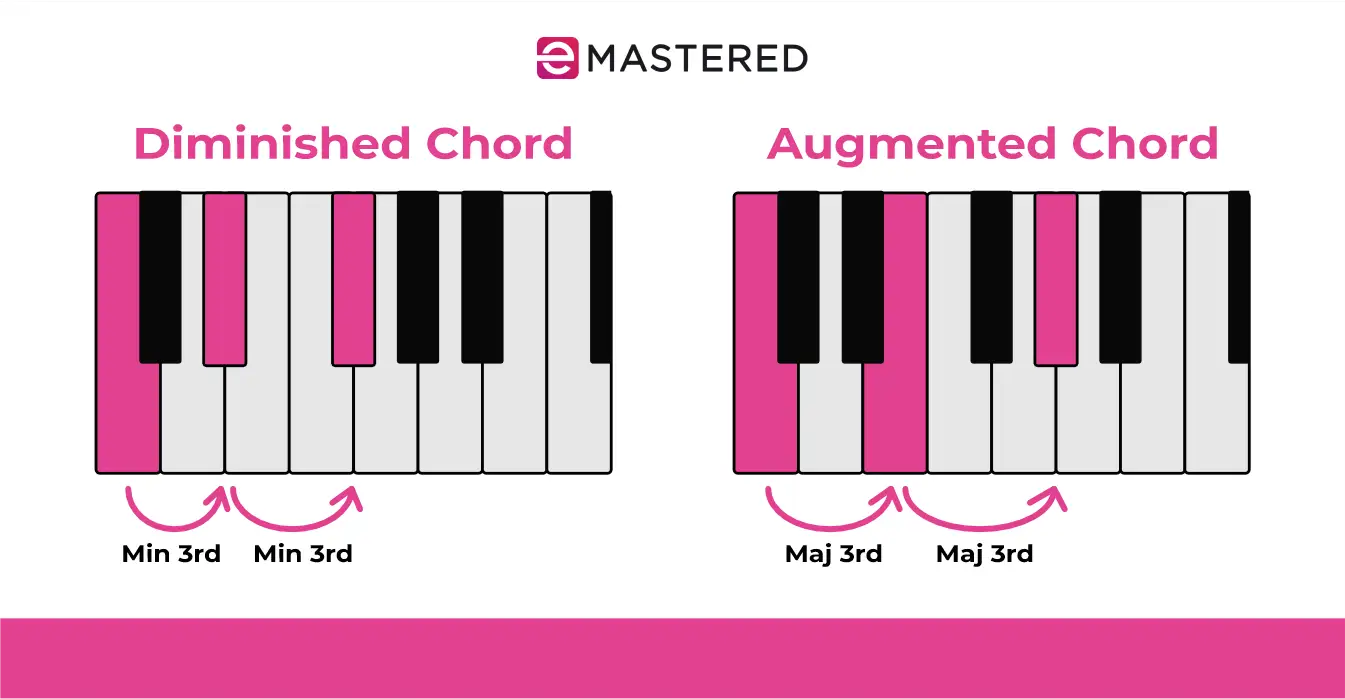
A regular diminished triad consists of a root note, a minor third, and a diminished fifth (six half steps above the root). For example, a C diminished triad (C dim) includes C, E♭, and G♭. However, we can also add a seventh on top for a bit more color to create a C dim7, for which the notes would be C, E♭, G♭, and B♭♭ (A).
Then, we have augmented chords, which are major chords with a raised fifth.
A regular augmented triad consists of a root note, a major third, and a raised fifth (eight half steps above the root). For example, a C augmented triad (C aug) includes C, E, and G#.
The BVii Chord
Another chord that often pops up in R&B is the ♭VII chord, also known as the "flat seven" chord.
This chord is built on the lowered seventh scale degree of a major key and is often used as a major chord, though it can also appear in other forms. In the key of C major, the ♭VII chord would be B♭ major (B♭-D-F).
Similar to the diminished chord, the ♭VII chord creates a sense of unexpected resolution and contrast within a progression. I use it whenever I want to take a break from the typical diatonic chords or modulate to new keys.
For example, if we wanted to move from C major to F major, we could use the B♭ major chord (B♭-D-F) to provide a smooth transition, acting as a bridge between the two keys.
7 R&B Chord Progressions to Add to Your Arsenal
Now that you have a better grip on the music theory or musical vocabulary involved in getting the unique R&B sound, let's take a look at some chord progressions you can experiment with. I recommend playing them as we go through the list on whatever instrument you have available!
1. Smooth Operator - i - v - iv - v
Sade is one of my favorite artists of all time, and to this day, "Smooth Operator" still feels as fresh as the first time I heard it. Sure, it could be that it's just a great song or that the production is incredibly slick, even to today's standards, but I think a lot of it has to do with the chord progression.
The song is in the key of D minor, and throughout, you hear a bunch of extended chords, which is why it has that smooth, jazzy feel.
- Dm7 : The choruses start off with the tonic chord to establish the minor key.
- Am7 : Next, it moves to minor v chord with a seventh extension to keep us in the minor feel
- Gm7 : We then move down one step to Gm7, which is the iv, reinforcing the minor key.
- Am7 : Lastly, we move back up to the minor v chord to lead us back to the tonic.
The chord progression is deceptively simple, but it's great for more soulful melodies.
2. I Get Lonely - i - vii - iii - VI - v - # vii
The chord progression from "I Get Lonely" will probably sound familiar for a few reasons. For starters, the song is an absolute classic, though secondly, the chord progression itself is built around your standard ii-V-I, similar to many other R&B songs.
The ii-V-I is probably one of the easiest chord progressions to pick out in a piece of music, even to the untrained ear.
The song itself is in the key of Dm, and the chord progression looks something like this:
- Dm9 : The track starts with the tonic to get us locked into the tonal center
- Cm9: From there, we get into a Cm9, which is an alternative to a regular ii-V-i movement
- F6/9: To step up out of the Cm9, we move to an F6/9
- B♭maj9: To end the first round of chords, we settle on a Bbmaj9, which is the VI of the d minor scale
- Am7: Jackson then uses a semitone step down to get us to the Am7 of the v of the progression
- Gm7♭5/D♭: This chord acts as a passing chord to get us back down to our i, and it's a bit complex. The chord consists of Gm7♭5 in the right hand and D♭ in the bass. In my opinion, the reason for this chord is the half-step movements, which give us the tension and eventual release back to the Dm9.
This is just the tip of the iceberg for this track, as it also has an incredible turnaround with an FM7sus2, a D/E, and an Aaug to get us back to the Dm9. I'd highly recommend digging into this progression in particular and analyzing how it works so well, even in an unexpected way.
3. "Between the Sheets" - VI - V- i - vii - VI
If you thought the above chord progression was a bit too complicated for your taste, I get it. For that reason, I want to get us back into a mellower realm with a chord progression that's a little bit more digestible.
"Between the Sheets" is an Isley Brothers classic that was famously sampled by Notorious B.I.G., as well as 40 other artists, according to WhoSampled. The song is in the key of A minor and it looks a bit something like this:
- Fmaj7 : Getting us off to a unique start, we begin on the VI chord
- E7♭9: From there, we move a step down to get to the dominant with a ♭9 for added flavor.
- Am9: Our first i chord appears halfway through the chord progression with an added 9
- Gm7: The downwards motion continues as we move down to a Gm7, which is the vii of A minor
- C9: Lastly, we get to a C9, which is the iii of A minor, though, again, with a slight bit of added flavor up top
4. 'My Boo" - VI - V - i -vii - iii
If you grew up in the early 2000s, there's no way you didn't hear Ghost Town DJs' "My Boo" on the radio all the time. Unlike many current pop songs, however, it has a wildly unique chord progression.
The song is in the key of F# minor, and similar to "Between the Sheets" we start off on the VI.
- Dmaj7 : We begin on the VI chord with a C# on top, though you can also use a Dmaj9
- C#aug7: From there, we move down a step to get to the first augmented chord we've looked at today, which is basically a major chord with a raised fifth, and, in this case, an added seventh up top.
- F#m9: The augmented chord acts as the dominant chord, bringing us to our first i chord.
- Em7: Continuing that downward motion, we move to an Em7, which is the vii chord
- A: And finally we get to a plain old A major, ending the minor chord progression on a high note.
5. The Dorian Groove - I - iii - IV - ii - V
Michael Jackson's "Rock with You" is a quintessential R&B/disco track from the 1979 album "Off the Wall."
The song was written by Rod Temperton, who was somewhat of a musical genius in the pop world. You can hear his chord work on many Michael Jackson tracks, from "Baby Be Mine" to "Thriller."
"Rock with You" is in the key of E♭ major, and while most of the chords in the song are diatonic, meaning they mostly belong to the key of E♭ major, there are some interesting variations and embellishments.
The intro and verse use the progression: E♭maj7 Gm7 A♭maj7 Fm7 B♭9
While the chord progression may look complicated, the music theory behind it makes sense:
- E♭maj7: This is the tonic chord or home key, which establishes a smooth, relaxed feel.
- Gm7 : From there, we some minor color with the iii chord, creating a stepwise motion that eventually moves into the IV chord.
- A♭maj7: To get a sense of lift, we get the IV chord. You'll hear this a lot in pop and R&B songs.
- Fm7: What's interesting is that he shifts away from the dominant or V and instead uses the ii chord to build tension, leading towards the dominant.
- B♭9: Finally, we get the V chord, which resolves back to the tonic. There's also an added 9th to give it a jazzier, richer sound.
6. "Thinking Bout You" - IV - ii - iii - vi - IV - iii - ♭III - ii
The interesting thing about Frank Ocean's "Thinking Bout You" is that it's in the key of C major, though it never touches C. The progression looks like this:
- Fmaj7: We start off with the IV chord with an added major seventh.
- Dm9: From there, we move to the second scale degree with an added ninth for color
- Em7: Taking a half-step up, we get to the iii chord
- Am7: Next, we move up to the vi of the key, which is the relative minor
- Fmaj7: Instead of going to the I, we go back around to the IV
- Em7: In the next go-around, we move to the iii instead of the ii, which eventually leads us to one of the most interesting chords in the progression.
- Ebmja7: This chord is where the color of the track comes from. It's a borrowed chord, as it doesn't exist naturally in C major. While this could be used as a modulation chord, it seems that Ocean uses it as a step-down back to the ii
- Dm7: Finally, we get to the Dm7, bringing the progression back to diatonic harmony.
7. "I Will Always Love You" - I - Vi - V - I
Let's end this list with a nice resolve, taking a break from the complex chords of the other R&B songs and end on something a bit simpler.
Whitney Houston's version of "I Will Always Love You," originally written by Dolly Parton, is known for its powerful vocals and emotive delivery. The chord progression in this song is relatively simple but effective in its uplifting nature, which could be worth using in your own songs!
The song is in the key of A major, and the chorus looks like this:
- A: The chorus starts us out on the root chord of the key, providing a strong tonic foundation.
- F#m: From there, we get to the relative minor chord, which adds a nice bit of melancholic color.
- E: As your ears might expect, we get to the dominant chord, which leads back to the tonic to create a sense of resolution.
- A: And there we are, back to square one!
It's worth noting that the chord progression in this song makes use of voice leading. There is a passing G# between the A and F#m and a passive E between the F#m and D. Even though it's one of the simpler chord progressions on this list, those passing tones give it a smoother feel.
Get Soulful With Your Own R&B Chord Progressions
While I would never advocate for anyone stealing any of these chord progressions and claiming them as their own, they can be great tools to use as you start writing R&B music.
The beauty of keeping these chord progressions in your back pocket is that you'll always be ready for jams when they come up. Plus, there's nothing sexier than busting out "I Get Lonely" on a Rhodes keyboard.
Beyond R&B, you can use these different chord progressions in other genres, such as jazz and blues music. Have fun, and we can't wait to hear what kind of music you come up with!


